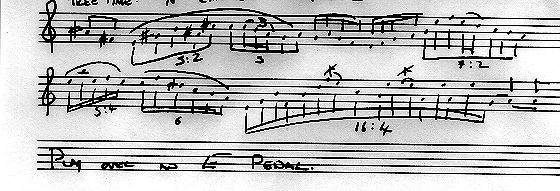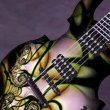In the field of music our views are always influenced by our peers, we watch other musicians and become inspired. This is of course true of the guitar player, it is often a life long ambition of ours to 'have that guy's chops'. This article however is designed to highlight the ways that other instruments and their players can profoundly effect us.
A few months ago I was given the privilege of performing some of my own music with a fantastic Indian Tabla player. The piece called "7 Veils" was completely improvised based on this mode (see example 1). It can be thought of in a number of ways, some call it the Gypsy scale , but it is essentially Phrygian Dominant with a #7 . I also make use of this mode in my tune "Sisterly Lust".

Example 1
The piece was rehearsed once before the concert at Strathclyde University, this rehearsal was to date the most simultaneously uplifting and humbling experience I have ever had. Vija (the tabla player) simply asked me what key the piece was in, if it was modal or diatonic and then we began to play. That one improvisation lasted one and a half hours (I kid you not!). Afterwards it occurred to me that for the first twenty minutes I had been constantly trying to think of ideas, I then realized that I had not been listening to anything Vija was doing.
He on the other hand was listening constantly, to every single thing I was doing and then fitting perfectly with those themes and playing off them, he knew where I was going even before I did. How is that possible? It's possible because he listens. A Tabla players ear is so highly developed that no matter what you play to them they will play it back to you perfectly first time. If you think this sounds unbelievable just check out any of Ravi Shankar's recordings and listen to what the Tabla is doing. When I had understood my folly the next hour and ten minutes was amazing, I forgot about what my fingers were doing and just listened, then I listened some more. Our piece moved through various stages, twisting and turning, ebbing and flowing until we finally finished on some gentle harmonics. To this day I can still feel the sound of them.
Okay, so what does all this hullaballa mean? Consider the idea of the Freudian ego, because whether or not you agree with Mr. Freud we all have them. Yes that's right, we guitarists really have large egos. Every musician considers them self to some degree, to be 'Gods gift to music' and it is only when we are confronted by amazing musicians playing music that we quite simply do not understand that we are made aware of our weaknesses. That my friends is extremely healthy, and that my friends...is the point.
As a musician your outlook on life should reflect the opinion that you never stop learning, ever. There is always someone better that can show you some of their tricks and bring you crashing down to earth. When our musical inadequacies are brought to light buy other individuals we are forced to change our perceptions and this alone can promote musical development. When we begin to understand this, our progression as musicians becomes inevitable.
To finish I would like to share with you some of the things that I learned from Vija Kangutar.
In contemporary popular music we are often confronted with similar rhythmic groupings, which can result in extremely stale music. Polyrhythms offer an interesting option to the adventurous, though certainly not the faint hearted. They have been used in Eastern Music for centuries as well as more recently in 20th Century Classical, notably Varese and Schoenberg.
The most simple example of a polyrhythm is a triplet, which presents 3 notes in the space where 2 would normally be (see Example 2). This can be extended to any number of tuplets, groups of 9 and 13 perhaps. The Tabla player has the ability to play these groupings while keeping the solid beat going, all this with one set of hands. Think of a drummer tapping 1/4 notes in a 4/4 bar with his feet while playing groups of 7 with his hands. Pretty scary stuff!

Example 2

Example 3
As guitarists we should practice polyrhythms by playing odd groupings while the metronome clicks straight beats. Try playing Example 3 which essentially a bar of 8th note triplets (ie. 3 triplets in the space of every 2 8th notes). You will notice that the metronome does not click on the accents of the triplet groupings. You are essentially playing a polyrhythm with the metronome. Try this exercise with more difficult groupings like 5 or 11 or 567 (maybe not). Lastly, try playing different groups of tuplets in the same bar, this is extremely difficult. I will be touching more in depth on polyrhythms in my column "A touch of Zappa", but until then you would do well to check out "The Frank Zappa Guitar Book" as well as Steve Vai's article on polyrhythms at www.vai.com.
Scottish guitarist Gerry Magee has recently completed work on his debut solo album, entitled "The Middle Pillar". He has been teaching guitar privately for five years to students of all styles and abilities.
Prior to recording "The Middle Pillar", Gerry performed as a guitarist and composer for the group Serenade on their second release, "The 28th Parallel".
